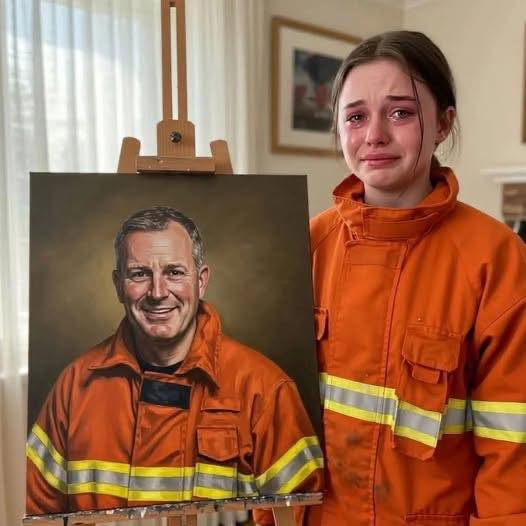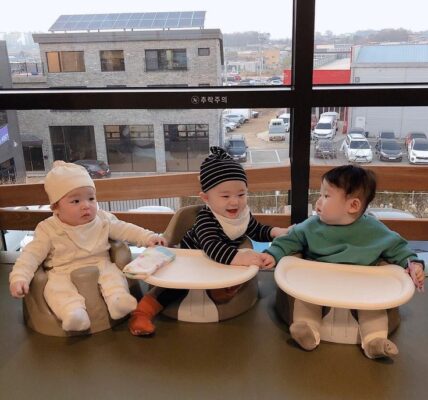The smell of paint still lingered in the living room as Lily stood beside the easel, her eyes red, her heart pounding. Her hands trembled—not from fatigue, but from the emotions that surged through her like a tidal wave.
She had just finished the most important painting of her life: a portrait of her father.
Not just a firefighter. He was her firefighter—her protector, her rock, the man who used to carry her on his shoulders and promise her the world was safe as long as he was around. Until, one rainy night, he ran into a burning building to save three children. He succeeded. But he never came out.
The world mourned him for a week. Flags at half-mast. A medal. A folded flag. Speeches. But soon, life moved on. The firehouse got a new captain. The news found other stories. Even her school friends stopped asking how she was doing after the second month.
But Lily didn’t move on. She couldn’t.
So, she picked up a brush.
Day after day, while others forgot, she remembered—every wrinkle near his eyes when he smiled, the scar on his chin from when he slipped fixing her treehouse, the way his uniform always smelled faintly of smoke and peppermint gum. She poured it all onto the canvas.
It took her three months. Not because she wasn’t good—she was—but because every time she painted his eyes, she’d start crying. She had to pause. Wipe her tears. Start again. She wanted to capture them exactly how she remembered: kind, brave, full of mischief and warmth.
No one knew about the painting. She had kept it secret.
Her mother was too consumed in her own grief to notice, spending most of her days in the garden, pruning already perfect roses. Teachers stopped calling home. Friends drifted away. She was alone with her memories and her colors.
When she finally unveiled the painting to her mother, hoping—just hoping—for a smile, maybe a tear, or even a whisper of pride, her mother only glanced and said, “It’s a nice likeness,” before walking away.
At school, she brought a photo of the portrait on her phone, showing it to a few classmates. One replied, “Why would you paint a dead person?” Another said, “Looks like something AI could do.” One boy laughed. She didn’t show anyone else after that.
And yet, she kept painting. Because this wasn’t for them.
It was for him.
She wore his old uniform jacket as she painted. It was too big, sleeves bunched up at the wrists, but it made her feel close to him. As if his spirit was guiding her hand with every stroke.
The day she finished, she placed the portrait on the easel, stepped back, and stared.
There he was.
Alive in color.
Smiling, proud, gentle.
She didn’t notice the tears flowing again until one dropped onto her cheek, sliding slowly into the collar of the jacket. Her breath hitched, and she looked away from the painting, as if ashamed of her emotions.
But then, something strange happened.
She heard him.
No, not a sound. Not really. But in her mind, she heard his voice:
“I’m proud of you, pumpkin.”
And with that, something inside her cracked wide open.
She dropped to her knees and sobbed—not because she was sad, but because, for the first time in a long time, she felt seen. Not by the world. But by him.
Later that week, a local art competition was announced: “Paint What You Love.” Lily didn’t hesitate. She entered the portrait. She almost didn’t go to the exhibit, fearing no one would care.
But she went.
And people did care.
The portrait stopped strangers in their tracks. Children asked who the man was. Parents grew quiet, some even teared up. One firefighter, seeing the painting, stood frozen for a long time before whispering, “I knew him.”
By the end of the evening, the judges awarded her first place—not just for technique, but for heart.
News spread.
A local reporter wrote an article: “Teen Honors Fallen Father with Moving Portrait.” It went viral. Suddenly, her inbox was filled with messages—firefighters from all over the country, widows, daughters like her, saying how much the painting meant to them.
But the most important moment came days later.
She came home to find her mother sitting in front of the painting, weeping.
Not quiet tears, but deep, aching sobs.
“I didn’t know,” her mother whispered, looking up. “I didn’t know you still felt him this strongly.”
Lily sat beside her.
“I had to do something,” she said. “Everyone else forgot. I couldn’t.”
Her mother reached out and held her for the first time in months.
“I’m sorry,” she said. “He would’ve loved this. He would’ve loved you for this.”
They stayed like that for a long time, the painting watching over them like a guardian angel in orange.
Months later, Lily would be asked to do more portraits—of other heroes, of those lost too soon. But none would ever mean as much as the one she painted in silence, in pain, and in love.
Because that painting wasn’t just art.
It was her goodbye.
And also, her hello again.





